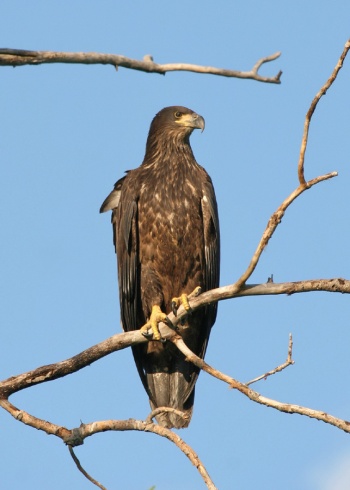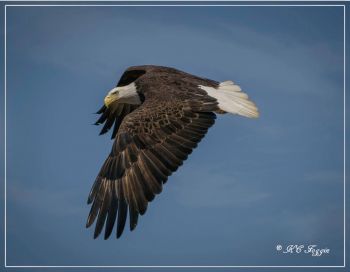Nomdeploom (talk | contribs) m (→Taxonomy) |
(→External Links: New Video search created) |
||
| (32 intermediate revisions by 9 users not shown) | |||
| Line 1: | Line 1: | ||
| + | [[File:Bald_Eagle_Perched_STF.jpg|thumb|550px|right|Photo © by {{user|STEFFRO1|Robert Steffens}}<br />[[Huntington Beach State Park]], [[South Carolina]], [[USA]], 29 December 2015]] | ||
;[[:Category:Haliaeetus|Haliaeetus]] leucocephalus | ;[[:Category:Haliaeetus|Haliaeetus]] leucocephalus | ||
| − | [[Image: | + | ==Identification== |
| − | + | [[Image:IMG 6622 57-1bf.jpg|thumb|350px|right|Immature<br />Photo © by {{user|Jim+Crosswell|Jim Crosswell }}<br />Windsor, [[Ontario]], July 2008 ]] | |
| − | |||
L. 30-31" (76-79 cm)<br/> | L. 30-31" (76-79 cm)<br/> | ||
W. 6-7' 6" (1.8-2.3 m)<br/> | W. 6-7' 6" (1.8-2.3 m)<br/> | ||
| Line 9: | Line 9: | ||
*Heavy yellow bill<br/> | *Heavy yellow bill<br/> | ||
| − | + | '''Immature''' birds lack the white head and tail (resembling adult [[Golden Eagle]]). The have a black bill and a varying amount of white plumage. | |
| + | ==Distribution== | ||
| + | [[File:Bald_Eagle_2ndYear_FRCRK.jpg|thumb|350px|right|2nd Year<br />Photo © by {{user|Forcreeks|Forcreeks}}<br />Jennings Lodge, [[Oregon]], [[USA]], 29 March 2021]] | ||
| + | Breeds from [[Alaska]] east to [[Newfoundland]] and south locally to [[California]], [[Great Lakes]], and [[Virginia]]; also in [[Arizona]], along [[Gulf Coast]], and in [[Florida]]. Formerly more widespread. Winters along coasts and large rivers in much of [[United States]]. | ||
| + | ====Endangered Status==== | ||
| + | The Bald Eagle was delisted (removed from) the Endangered Species List by the Department of Interior of the federal government of the USA on June 28th, 2007. | ||
| − | == | + | ==Taxonomy== |
| − | + | [[File:Bald_Eagle_Flight_KC.jpg|thumb|350px|right|Photo © by {{user|KC+Foggin| KC Foggin}}<br />Myrtle Beach, [[South Carolina]], [[USA]], April 2021]] | |
| + | ====Subspecies==== | ||
| + | There are 2 subspecies<sup>[[#References|[1]]]</sup>: | ||
| + | *''H. l. washingtoniensis'': | ||
| + | :*Locally in [[Aleutian Islands]], [[Alaska]], [[Canada]] and northern [[US]] | ||
| + | *''H. l. leucocephalus'': | ||
| + | :*Locally from southern [[US]] to north-western [[Mexico]] | ||
| − | ==Habitat | + | A third subspecies ''alascanus''<sup>[[#References|[2]]]</sup> is not recognised by all authorities. |
| − | Lakes, rivers, marshes, and seacoasts. | + | ==Habitat== |
| + | Lakes, rivers, marshes, and seacoasts Goes into residential areas, especially in winter. | ||
| + | ==Behaviour== | ||
| + | ====Breeding==== | ||
| + | They build a large nest of sticks on top of a cliff or in a tall tree. Two to three white eggs are laid. | ||
| + | ====Diet==== | ||
| + | Their main diet is fish, which is snatched from the surface of water. Alternatively they will rob an [[Osprey]] of its catch | ||
| + | ====Vocalisation==== | ||
| + | Squeaky cackling and thin gull-like squeals. | ||
| + | {{ Audio|BaldEagleMVI_7743.mp3 }} | ||
| − | + | [[Media:BaldEagleMVI_7743.mp3|Bald Eagle sound clip]]<br /> | |
| − | + | Recording © by {{user|jmorlan|Joseph Morlan}}<br /> | |
| + | San Jose, [[California]], [[USA]]. 05 August 2020 | ||
| − | == | + | ==Gallery== |
| − | + | Click on photo for larger image | |
| − | + | <gallery> | |
| − | + | Image:614 15948fg Second Year Bald Eagle in Flight-1.jpg|Second year<br />Photo © by {{user|bobsofpa|bobsofpa}}<br />Conowingo Dam, [[Maryland]], [[USA]], December 2014 | |
| − | + | Image:614 15905fg Third Year Bald Eagle in Flight-1.jpg|Third year<br />Photo © by {{user|bobsofpa|bobsofpa}}<br />Conowingo Dam, [[Maryland]], [[USA]], December 2014 | |
| − | + | Image:614 15910fg Fourth Year Bald Eagle in Flight-1.jpg|Fourth year<br />Photo © by {{user|bobsofpa|bobsofpa}}<br />Conowingo Dam, [[Maryland]], [[USA]], December 2014 | |
| − | == | + | Image:Eagle Bald 2018-03-14 176.jpg|Courtship display<br />Photo © by {{user|ducbucln|ducbucln}}<br />Kelseyville, [[California]], March 2018 |
| − | + | </gallery> | |
| − | + | ==References== | |
| − | + | #{{Ref-Clements6thAug19}}#Lepage D. (2021) [Avibase - https://avibase.ca/E3E9FEB9]. Retrieved 1 March 2021 | |
| + | {{ref}} | ||
| + | ==External Links== | ||
| + | {{GSearch|"Haliaeetus leucocephalus" {{!}} "Bald Eagle"}} | ||
| + | <br /> | ||
| + | {{VSearch|"Haliaeetus leucocephalus" {{!}} "Bald Eagle", video}} | ||
| + | {{GS-checked}}1 | ||
| + | <br /> | ||
| + | <br /> | ||
| − | + | [[Category:Birds]] [[Category:Haliaeetus]] [[Category:Videos]] | |
| − | |||
| − | [[Category:Birds]] [[Category:Haliaeetus]] | ||
Latest revision as of 20:07, 10 April 2023
- Haliaeetus leucocephalus
Identification
L. 30-31" (76-79 cm)
W. 6-7' 6" (1.8-2.3 m)
- Large blackish eagle
- White head and tail
- Heavy yellow bill
Immature birds lack the white head and tail (resembling adult Golden Eagle). The have a black bill and a varying amount of white plumage.
Distribution
Breeds from Alaska east to Newfoundland and south locally to California, Great Lakes, and Virginia; also in Arizona, along Gulf Coast, and in Florida. Formerly more widespread. Winters along coasts and large rivers in much of United States.
Endangered Status
The Bald Eagle was delisted (removed from) the Endangered Species List by the Department of Interior of the federal government of the USA on June 28th, 2007.
Taxonomy
Subspecies
There are 2 subspecies[1]:
- H. l. washingtoniensis:
- Locally in Aleutian Islands, Alaska, Canada and northern US
- H. l. leucocephalus:
A third subspecies alascanus[2] is not recognised by all authorities.
Habitat
Lakes, rivers, marshes, and seacoasts Goes into residential areas, especially in winter.
Behaviour
Breeding
They build a large nest of sticks on top of a cliff or in a tall tree. Two to three white eggs are laid.
Diet
Their main diet is fish, which is snatched from the surface of water. Alternatively they will rob an Osprey of its catch
Vocalisation
Squeaky cackling and thin gull-like squeals.
Bald Eagle sound clip
Recording © by Joseph Morlan
San Jose, California, USA. 05 August 2020
Gallery
Click on photo for larger image
Courtship display
Photo © by ducbucln
Kelseyville, California, March 2018
References
- Clements, J. F., T. S. Schulenberg, M. J. Iliff, S. M. Billerman, T. A. Fredericks, B. L. Sullivan, and C. L. Wood. 2019. The eBird/Clements Checklist of Birds of the World: v2019. Downloaded from http://www.birds.cornell.edu/clementschecklist/download/
- Lepage D. (2021) [Avibase - https://avibase.ca/E3E9FEB9]. Retrieved 1 March 2021
Recommended Citation
- BirdForum Opus contributors. (2024) Bald Eagle. In: BirdForum, the forum for wild birds and birding. Retrieved 13 May 2024 from https://www.birdforum.net/opus/Bald_Eagle
External Links
GSearch checked for 2020 platform.1











